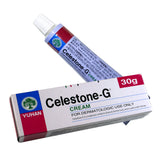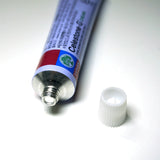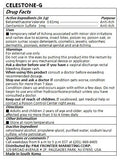Celestone-G 30g
- Type: Dermatologic Cream
-
Action:
Skin Rash, Itching, Eczema, Psoriasis, Phimosis,
Atopic Dermatitis, Contact Dermatitis, Seborrheic Dermatitis, Photo Dermatitis, Exfoliative Dermatitis, Lichen Simplex Chronicus, Intertrigo, Ataxia Telangiectasia
- Secondary infected allergic or inflammatory skin disease
- This cream may also be used for purposes not listed here
- Active Ingredient (in 1g):
Bethamethasone Valerate-------0.61mg
Gentamicin Sulfate-------------------1mg
- Weight:
30g (1.05oz)/Net
45g (1.58oz)/Net+Retail Box
- Expiration Date: Nov/2026 or Later
*YUHAN Pharm, Made in Korea
*Celestone-G is a trademark of Merck Sharp & Dohme Corp. and is used under license
Precaution
1. Do not administerate to the patient (or part) in below.
1) Patients with bacteria (tuberculosis, syphilis, etc.), fungi (tandidas, tinea), Spirochaete yeast virus (herpes zoster, herpes simplex, varicella), animal skin infections (scabies, phthiriasis pubis(crab louse)).
2) Patients with hypersensitivity or history of the drug or its components.
3) Patients with eczemic ophthalmoplegia with perforation of the eardrum (delayed healing of perforation sites may be occurred).
4) Patients with a second-degree or more profundus burn or frostbite (Skin regeneration is inhibited and healing may be delayed), Ulcers (except for Behcet's disease).
5) Patients with circumoral dermatitis, acne, rosacea
6) Patients with hypersensitivity to aminoglycoside antibiotics such as streptomycin, kanamycin, gentamicin, neomycin, or to bacitracin, and with its history.
2. The following patients should be administered with strong caution.
1) Pregnant women or possibly pregnant women and lactating women.
2) Infant and children
3. Side effects
1) Skin
(1) Infectious disease: Skin bacterial (infectious impetigo, folliculitis, etc.), and viral infections (it is likely to be occurred in the case of sealed bandage (ODT)). If such symptoms are occurred, use appropriate antimicrobial agents or antifungal agents, and if symptoms do not improve quickly, discontinue to use this cream.
(2) general skin symptoms: If symptoms such as folliculitis, swelling, skin irritation, sore throat, fever, burning sensation, rash / redness, flushing, dry skin, pustular dermatitis, stop using and consult with a doctor or pharmacist.
(3) Long term continuous use: Steroidal acne, steroidal skin (skin atrophy, capillary vasodilatation, purpura), steroidal injection, dermatitis in the occupied area (erythema in the upper part of the face and face, capillary dilation, scab, Bilateral skin changes, hair follicles, and pigment desalination. If you have any of these symptoms, slowly reduce your dose to a non-corticosteroid drug.
2) Endocrine system
Careness should be taken as it can be lead to the inhibition of pituitary and adrenal cortex functions such as systemic administration of corticosteroids by extensive use over a large or long period of time or sealing bandage.
3) Eyes
When using on eyelid skin, be careful because it may cause glaucoma rise. Extensive use over a long period of time, especially when using the sealed bandage method, may result in posterior subcapsular cataracts and glaucoma.
4) Fungus alternation phenomenon
In rare cases, this drug may cause infections due to non-susceptible bacteria.
5) Avoid long-term use because nephropathy and hardness of hearing may be occurred.
4. General precautions
1) Keep the prescribed directions and dosage.
2) For children, it should be used under supervision of the their parents or guardian.
3) Systemic absorption of topical corticosteroids may cause reversible hypothalamic-pituitary-adrenal (HPA) axis inhibition, Cushing's syndrome, hyperglycemia, diabetes mellitus, etc. in some patients, and thus local corticosteroids Routinely measures serum cortisol levels, cortisol liberated in the urine, or tests for HPA axis inhibition by ACTH stimulation.
4) If systemic absorption of topical corticosteroids inhibits the HPA axis, please stop useing this drug, reduce the frequency of administration, and replace it with a weakly active corticosteroid. In general, after stopping topical corticosteroid administration, HPA axis inhibition is recovered.
5) If symptoms do not improve or worsen, discontinue to use.
6) If symptoms improve, stop using as soon as possible.
7) Symptoms such as systemic administration of corticosteroids can be seen in large doses, prolonged periods, and in particular by using a sealed bandage method. Avoid long-term & bulk use and sealed bandage except in special cases.
8) Because it can be sensitized, please observe it sufficiently and stop using if sensitization signs (redness, swelling, papules, small scalds, etc.) appear.
9) Do not use long term.
10) Corticoids and gentamycin are known to be absorbed through the skin due to sealing bandage methods or broad-area applications, long-term use, etc. In these cases, a renal function test is recommended, such as a BUN test, before routine observation and treatment.
11) Gentamicin does not show systemic effects at the topical level, but it may cause permanent vestibular dysfunction in renal or eighth cranial nerves at concentrations that may be indicative of systemic toxicity.
5. Administration to pregnant and lactating women
1) Since the safety of pregnancy is not established, it should be administered only when pregnant women or a women who are likely to be pregnant should be avoided in large-scale (overdose) or long-term use, and the therapeutic benefit is judged to be higher than the risk.
2) It is still not known whether topically administered corticosteroids are transferred to breast milk, but well-known as systemic corticosteroids are transferred to breast milk, thus be careful when administering them to the breast feeding (lactating) women.
6. Administration to children
1) It is important to note that children are more likely to have HPA axis inhibition, Cushing 's syndrome, and developmental disorders due to the presence of corticoids because the body surface area ratio is greater than that of adults.
2) Please note that diapers and the like may exhibit the same function as the sealing bandage method.
3) When used in pediatric patients, only the minimum amount of treatment should be used.
7. Precautions for application
1) Do not use for ophthalmology.
2) Do not use for other purposes such as cosmetics or after shaving.
3) Do not use the sealing bandage method without supervision of a doctor. (Especially when using the sealing bandage method, bacterial infection is easy to be occurred. Clean the lesion before application).
8. Storage Precautions
Keep out from touching of children.
9. Other
It has been reported that psoriatic hyperplasia and pustular psoriasis are present in patients with psoriasis in the long term and in large doses during treatment or after cessation of treatment.






